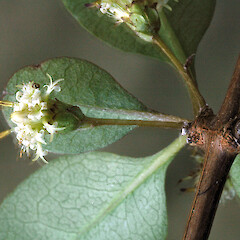Olearia gardneri
Common name
deciduous tree daisy
Synonyms
None
Family
Asteraceae
Flora category
Vascular – Native
Endemic taxon
Yes
Endemic genus
No
Endemic family
No
Structural class
Trees & Shrubs - Dicotyledons
Chromosome number
2n = 108
Current conservation status
The conservation status of all known New Zealand vascular plant taxa at the rank of species and below were reassessed in 2017 using the New Zealand Threat Classification System (NZTCS) – more information about this can be found on the NZTCS website. This report includes a statistical summary and brief notes on changes since 2012 and replaces all previous NZTCS lists for vascular plants.
Please note, threat classifications are often suggested by authors when publications fall between NZTCS assessment periods – an interim threat classification status has not been assessed by the NZTCS panel.
- Conservation status of New Zealand indigenous vascular plants, 2017 . 2018. Peter J. de Lange, Jeremy R. Rolfe, John W. Barkla, Shannel P. Courtney, Paul D. Champion, Leon R. Perrie, Sarah M. Beadel, Kerry A. Ford, Ilse Breitwieser, Ines Schönberger, Rowan Hindmarsh-Walls, Peter B. Heenan and Kate Ladley. Department of Conservation. Source: NZTCS and licensed by DOC for reuse under the Creative Commons Attribution 4.0 International licence.
2017 | Threatened – Nationally Endangered | Qualifiers: CD, RF
Previous conservation statuses
2012 | Threatened – Nationally Critical | Qualifiers: CD, RF
2009 | Threatened – Nationally Critical | Qualifiers: CD, RF
2004 | Threatened – Nationally Critical
Brief description
Rare small-leaved shrub with wide-angled, reddish, round stems with a prominent raised ridge on opposite sides; stems bearing clusters of thin leaves; inhabiting river valleys of the southern North Island. Leaves 10–15 mm long by 7–10 mm wide, oval. Flowers small, white, in small groups at base of leaves.
Distribution
Endemic. New Zealand: North Island (formerly known from Hawkeʻs Bay, southern central North Island (near Taihape) and Wairarapa. Now known only from the upper Turakina Valley, the vicinity of Mataroa near Taihape and from widely scattered sites in the eastern Wairarapa; in 2014 a new population was found east of Masterton, comprising more shrubs (some 400) than all other known populations combined.
Habitat
The exact habitat preferences of this species are unclear. The majority of plants have been gathered from mataī/tōtara/kahikatea forest remnants on alluvial terraces, developed on calcareous siltstones. In these habitats O. gardneri is associated with the dense shrub tier dominated by numerous divaricating shrubs and trees, which is common to this forest type in the drier eastern North Island. Plants often grow adjacent to semi-permanent water pools or in sites flooded in winter.
Detailed description
Deciduous shrub or small tree up to 3 m tall; stems often layering. Bark greyish–white, rough, grooved. Branchlets with 2 flanges, slender, dark reddish brown. Leaves of seedlings broadly deltoid, margins with 3–4 prominent teeth. Leaves of adults opposite or in fascicles of 2–4 on brachyblasts, spathulate, petioles 5–10 mm long mm; lamina 10–35 × 7–17 mm, broadly ovate-elliptic, light green above, more or less glabrous below with a few scattered long and silky hairs but no tomentum, margin entire, apex obtuse and apiculate. Inflorescences solitary or in fascicles of 2–6 capitula on brachyblasts. Capitula c. 5 × 4 mm, peduncles 6–10 mm long. Involucral bracts c. 16, obovate, glabrous, membranous, purple tinged, apex acute. Florets 10–19, white. Ray florets c. 9, 5 mm long, limb c. 1 mm long. Disc florets c. 10, 6 mm long, lower half of corolla tube with very short, rather glandular hairs. Achenes 1–2 mm long, narrow–obovate, with short patent or slightly antrorse hairs; pappus hairs 2–3 mm long.
Similar taxa
Olearia gardneri is allied to the South Island O. hectorii Hook.f. From that species it differs by the broadly deltoid, truncate, rather than oblanceolate juvenile leaves, by the smaller, distinctly less hairy adult leaves, white rather than yellow flowers, and narrowly lanceolate, toothed, finely hairy phyllaries (bracts surrounding the flowers). The phyllary hairs are long and wavy.
Flowering
October–December
Flower colours
White
Fruiting
February–April
Propagation technique
Can be grown from fresh seed when available. Hardwood cuttings will strike if taken after leaf fall and placed within a cold frame.
Threats
Approx 500 adult specimens left in the wild. Many sites are single plants, often in ill-thrift and/or growing in severely deteriorated habitats. This species remains acutely threatened through recruitment failure (the seed cannot germinate through the dense grass swards which now surround most trees), the ill-thrift and presumed old-age of many of the surviving trees. Indications are that seed produced by many trees has very low viability, and there are concerns that the species may have a high level of self-incompatibility. This will seriously impact on current management practices which involve harvesting seed from the wild, germinating plants, and planting these back directly under their parent tree(s).
Etymology
olearia: Named after Johann Gottfried Olearius, a 17th-century German scholar, writer of hymns and author of Specimen Florae Hallensis
gardneri: Commemorating the New Zealand botanist Rhys O. Gardner (1949-)
Note
Numerous specimens grow in the grounds of the Masterton Office, New Zealand Department of Conservation, and at Pukaha Mount Bruce National Wildlfie Centre.
Attribution
Fact Sheet prepared for NZPCN by P.J. de Lange 1 July 2007. Description by P.B. Heenan and P.J. de Lange subsequently published in de Lange et al. (2010); revisions and additions C. Ogle 2018, mainly to note the 2014 find of a new, relatively large population near Masterton
References and further reading
de Lange PJ, Heenan PB, Norton DA, Rolfe JR, Sawyer JWD. 2010. Threatened Plants of New Zealand. Canterbury University Press, Christchurch. 471 p.
Heads M. 1998. Biodiversity in the New Zealand divaricating tree daisies: Olearia sect. nov. (Compositae). Botanical Journal of the Linnean Society 127(3): 239-285. https://doi.org/10.1111/j.1095-8339.1998.tb02100.x.
NZPCN Fact Sheet citation
Please cite as: de Lange, P.J. (Year at time of access): Olearia gardneri Fact Sheet (content continuously updated). New Zealand Plant Conservation Network. https://www.nzpcn.org.nz/flora/species/olearia-gardneri/ (Date website was queried)






















